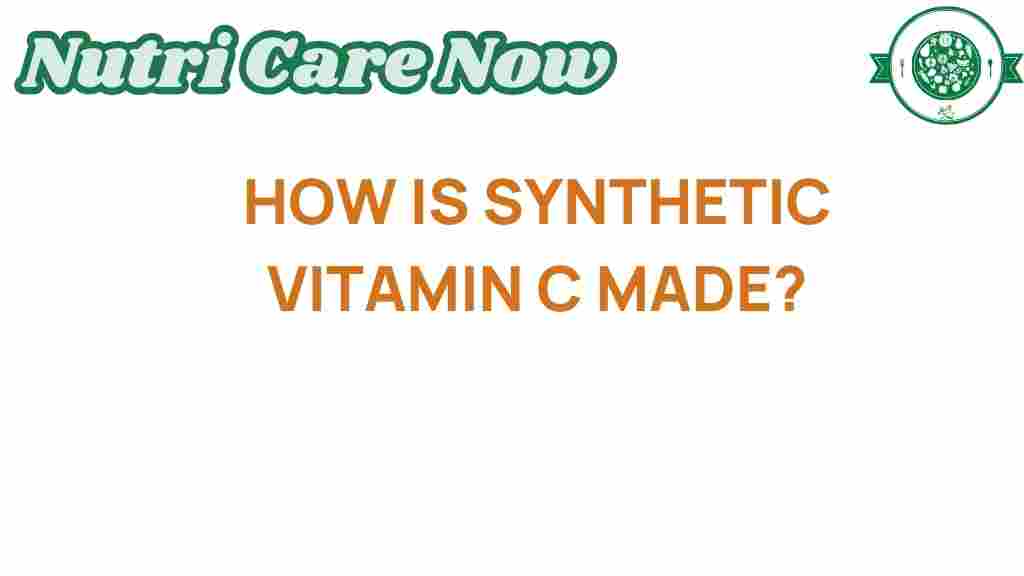Unraveling the Mystery: How Is Synthetic Vitamin C Made?
Vitamin C, also known as ascorbic acid, is an essential nutrient that plays a vital role in our health and well-being. While many people get their vitamin C from fruits and vegetables, synthetic vitamin C is a popular alternative found in supplements and fortified foods. But how is synthetic vitamin C made? In this article, we will explore the production process of synthetic vitamin C, its health benefits, and its bioavailability compared to natural sources.
The Importance of Vitamin C in Nutrition
Vitamin C is a water-soluble vitamin that is crucial for various bodily functions, including:
- Boosting the immune system
- Supporting collagen synthesis
- Enhancing iron absorption
- Acting as a powerful antioxidant
Considering these health benefits, it’s clear why many individuals turn to synthetic vitamin C in their daily nutrition. The production of synthetic vitamin C involves a complex manufacturing process that ensures a consistent and effective product.
The Production Process of Synthetic Vitamin C
The manufacturing of synthetic vitamin C typically involves a multi-step chemical process. Here, we unravel how ascorbic acid is produced synthetically.
Step 1: Starting Materials
The production of synthetic vitamin C begins with simple sugars, predominantly glucose. Glucose can be derived from starch, which is abundant in plants. This sugar is the foundation of the synthetic vitamin C production process.
Step 2: Fermentation
In the first stage, the glucose undergoes fermentation. This process involves specific microorganisms that convert glucose into sorbitol, a sugar alcohol. This fermentation is crucial as it transforms the starting material into a precursor for vitamin C.
Step 3: Hydrogenation
Once sorbitol is obtained, it undergoes hydrogenation. This process involves adding hydrogen to sorbitol to produce another intermediate compound, which is essential for further processing. The use of catalysts in hydrogenation ensures efficiency and higher yields in the production process.
Step 4: Conversion to Ascorbic Acid
The next step is the conversion of the intermediate compound into ascorbic acid. This is accomplished through a series of chemical reactions, including oxidation and rearrangement. The final result is pure synthetic vitamin C—ascorbic acid.
Step 5: Purification and Crystallization
After the synthesis of ascorbic acid, the product undergoes purification to remove any impurities. This typically involves filtration and crystallization processes to ensure that the synthetic vitamin C produced is of high quality and suitable for use in supplements and foods.
Quality Control in Manufacturing
Throughout the production process, quality control is essential. Manufacturers must ensure that the synthetic vitamin C meets specific standards for purity, potency, and bioavailability. Rigorous testing is conducted at various stages of production to guarantee that the final product is safe and effective for consumers.
Health Benefits of Synthetic Vitamin C
Synthetic vitamin C offers numerous health benefits similar to those of natural vitamin C sources. Here are some notable advantages:
- Immune Support: Regular intake of vitamin C can enhance the body’s immune response.
- Antioxidant Properties: It helps combat oxidative stress, which can lead to chronic diseases.
- Skin Health: Vitamin C is vital for collagen production, aiding in skin elasticity and repair.
- Improved Iron Absorption: It enhances the absorption of non-heme iron from plant-based foods.
Moreover, synthetic vitamin C is often more affordable and accessible than its natural counterparts, making it a popular choice for many individuals seeking to boost their vitamin intake.
Bioavailability of Synthetic Vitamin C
Bioavailability refers to the extent and rate at which the active ingredient or active moiety is absorbed and becomes available at the site of action. When it comes to synthetic vitamin C, research indicates that its bioavailability is comparable to that of natural vitamin C. Factors influencing bioavailability include:
- Form of Vitamin C: Different forms of vitamin C (such as ascorbic acid versus sodium ascorbate) can affect absorption rates.
- Dietary Factors: The presence of other nutrients, such as flavonoids, can enhance the absorption of vitamin C.
- Individual Differences: Age, metabolism, and overall health can influence how well vitamin C is absorbed in the body.
Because synthetic vitamin C is chemically identical to natural vitamin C, it is generally accepted that it provides similar health benefits and is easily absorbed by the body.
Troubleshooting Tips for Vitamin C Use
While synthetic vitamin C is beneficial, some individuals may experience side effects or issues related to its consumption. Here are some troubleshooting tips:
- Gastrointestinal Issues: If you experience stomach upset, consider reducing your dosage or taking it with food.
- Allergic Reactions: If you notice any allergic symptoms, discontinue use and consult a healthcare professional.
- Interference with Medications: Always check with your doctor if you are on medication that may interact with vitamin C.
Proper usage and dosing are essential to maximize the benefits of synthetic vitamin C while minimizing potential side effects.
Conclusion
In conclusion, synthetic vitamin C, or ascorbic acid, is produced through a sophisticated manufacturing process that transforms simple sugars into a vital nutrient that offers numerous health benefits. Its bioavailability is comparable to that of natural vitamin C, making it an effective choice for supplementation. Understanding the production process and benefits of synthetic vitamin C can help consumers make informed decisions about their nutritional needs.
If you’re interested in learning more about vitamins and nutrition, you can explore additional resources here. For more information on health supplements, visit this site.
This article is in the category Supplements and created by NutriCareNow Team
